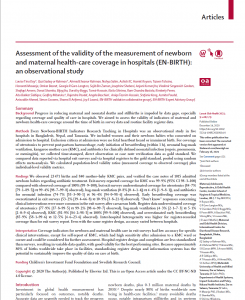
Background
Progress in reducing maternal and neonatal deaths and stillbirths is impeded by data gaps, especially regarding coverage and quality of care in hospitals. We aimed to assess the validity of indicators of maternal and newborn health-care coverage around the time of birth in survey data and routine facility register data. Methods Every Newborn-BIRTH Indicators Research Tracking in Hospitals was an observational study in five hospitals in Bangladesh, Nepal, and Tanzania. We included women and their newborn babies who consented on admission to hospital. Exclusion critiera at admission were no fetal heartbeat heard or imminent birth. For coverage of uterotonics to prevent post-partum haemorrhage, early initiation of breastfeeding (within 1 h), neonatal bag-mask ventilation, kangaroo mother care (KMC), and antibiotics for clinically defined neonatal infection (sepsis, pneumonia, or meningitis), we collected time stamped, direct observation or case note verification data as gold standard. We compared data reported via hospital exit surveys and via hospital registers to the gold standard, pooled using random effects meta-analysis. We calculated population-level validity ratios (measured coverage to observed coverage) plus individual-level validity metrics.
Findings
We observed 23471 births and 840 mother–baby KMC pairs, and verified the case notes of 1015 admitted newborn babies regarding antibiotic treatment. Exit-survey-reported coverage for KMC was 99·9% (95% CI 98·3–100) compared with observed coverage of 100% (99·9–100), but exit surveys underestimated coverage for uterotonics (84·7% [79·1–89·5]) vs 99·4% [98·7–99·8] observed), bag-mask ventilation (0·8% [0·4–1·4]) vs 4·4% [1·9–8·1]), and antibiotics for neonatal infection (74·7% [55·3–90·1] vs 96·4% [94·0–98·6] observed). Early breastfeeding coverage was overestimated in exit surveys (53·2% [39·4–66·8) vs 10·9% [3·8–21·0] observed). “Don’t know” responses concerning clinical interventions were more common in the exit survey after caesarean birth. Register data underestimated coverage of uterotonics (77·9% [37·8–99·5] vs 99·2% [98·6–99·7] observed), bag-mask ventilation (4·3% [2·1–7·3] vs 5·1% [2·0–9·6] observed), KMC (92·9% [84·2–98·5] vs 100% [99·9–100] observed), and overestimated early breastfeeding (85·9% (58·1–99·6) vs 12·5% [4·6–23·6] observed). Inter-hospital heterogeneity was higher for register-recorded coverage than for exit survey report. Even with the same register design, accuracy varied between hospitals.
Interpretation
Coverage indicators for newborn and maternal health care in exit surveys had low accuracy for specific clinical interventions, except for self-report of KMC, which had high sensitivity after admission to a KMC ward or corner and could be considered for further assessment. Hospital register design and completion are less standardised than surveys, resulting in variable data quality, with good validity for the best performing sites. Because approximately 80% of births worldwide take place in facilities, standardising register design and information systems has the potential to sustainably improve the quality of data on care at birth.